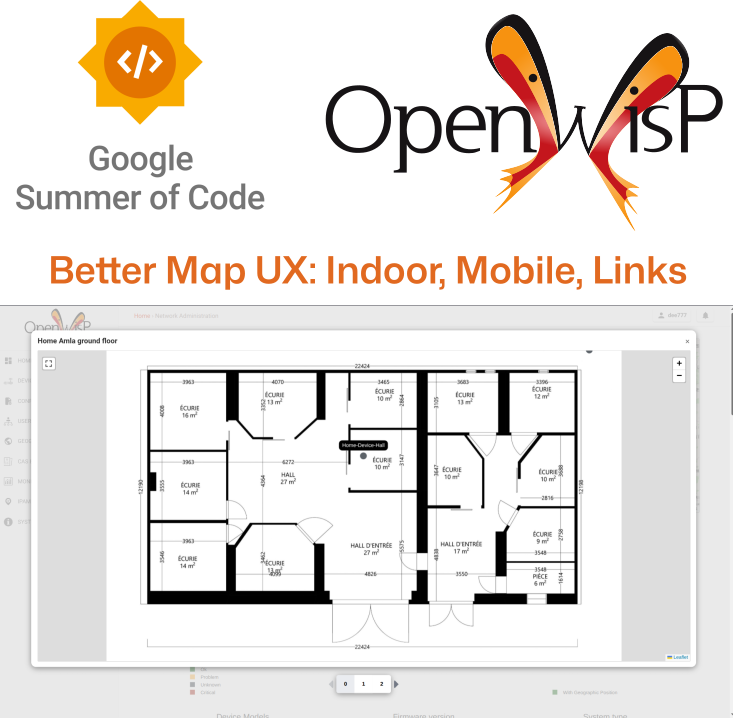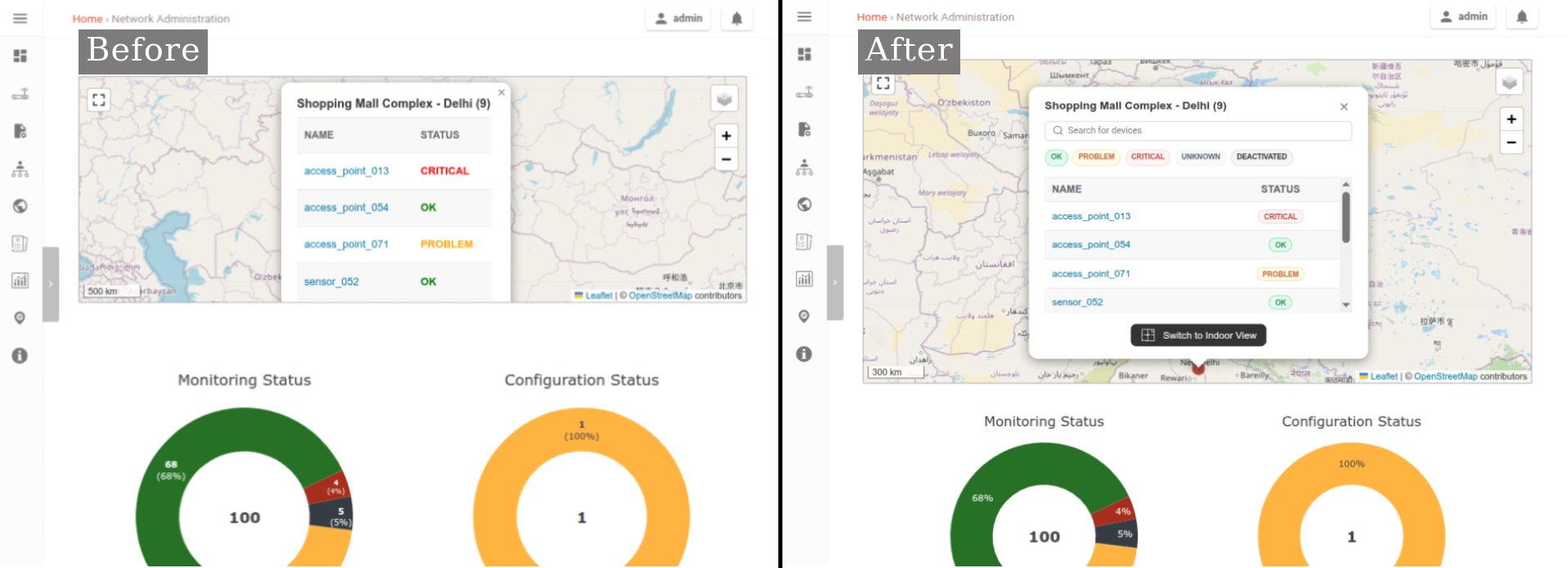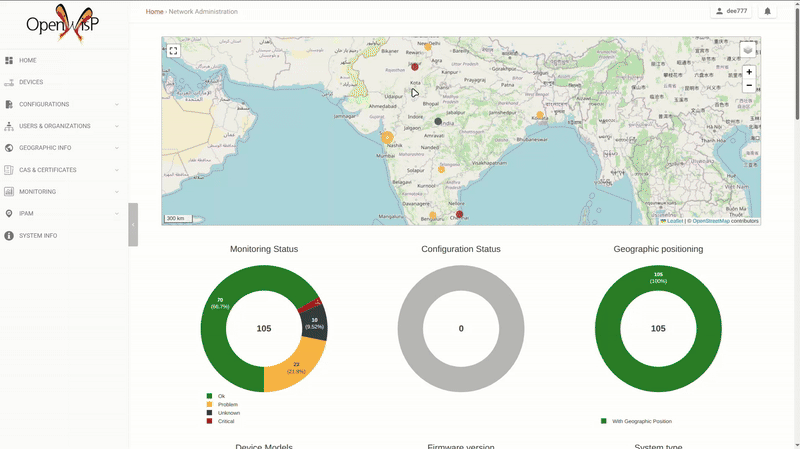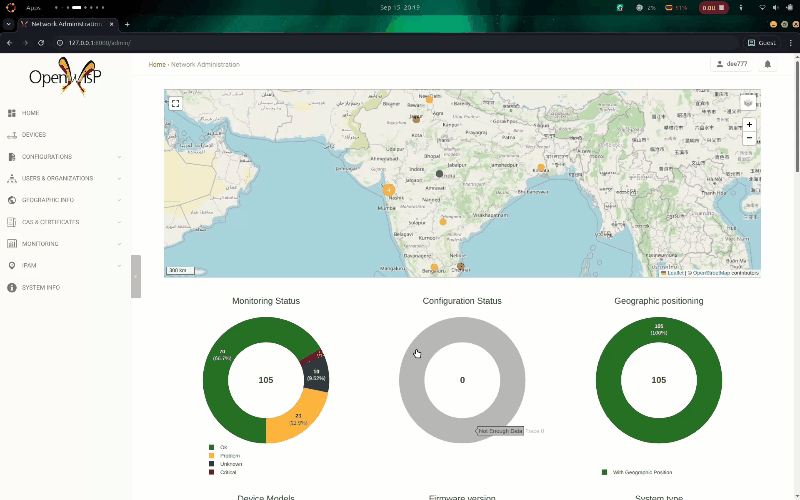GSoC 2025: Better Map UX: Indoor, Mobile, Linkable URLs
Published on by Deepanshu Sahu
Category: gsoc

Participating in Google Summer of Code has been a transformative experience. Over the past three months, I worked on my Google Summer of Code project with OpenWISP, where I had the opportunity to enhance the platform by improving its general map functionalities. With the constant guidance, encouragement, and expertise of my mentors Federico Capoano (nemesifier) and Gagan Deep (pandafy). I was able to explore new technologies, tackle complex problems, and deliver features that significantly improve usability, navigation, and accessibility in network visualization tools. Their insightful feedback, patience, and supportive mentorship played a crucial role in helping me grow as a developer and a contributor to open-source projects.
About the Project
The project aimed to enhance the OpenWISP general map with features that improve accessibility, navigation, and monitoring for network administrators. Key additions include indoor floor plan integration, linkable map URLs, and real-time mobile device tracking. These improvements help users manage complex networks more effectively and troubleshoot issues with ease.
The experience presented significant technical challenges that deepened my understanding of mapping libraries like Leaflet.js and netjsongraph.js, while also offering opportunities to collaborate with the open-source community and contribute to a project with global impact.
Additionally, I contributed a fix for Django Channels ChannelsLiveServerTestCase class, which had become incompatible with Django 5.2. I also added a sample project with Selenium tests to ensure future compatibility, so that any changes to Django internals that might break the test setup can be caught early.
Building the General Map Enhancements
My contributions focused on making the map interface more intuitive and interactive. I added features like device search, status-based filtering, and seamless access to indoor maps from the general map view. Users can now view specific devices within floor plans, switch between floors, and open maps in fullscreen mode for better visualization. Additionally, users can share URLs that link directly to specific nodes, graph states, or zoom levels, making navigation and collaboration much easier.

Features Implemented
UI improvements on Location Pop-up

The location pop-up in the dashboard map has been enhanced to improve usability and navigation. Users can now search for devices by name and filter them by labels directly within the map interface through a popup above the map. After filtering, users can quickly navigate to the detailed page of the selected device. Additionally, devices associated with floor plans include a button that opens the corresponding floor layout overlay for better visualization.
To optimize performance, infinite scroll has been implemented in the device list table to load data efficiently as users scroll. A debounce mechanism is also applied to the search input, ensuring that unnecessary queries are minimized and the interface remains responsive.
Indoor Map View

If a device has an associated floor plan, a button is displayed that opens the floor plan overlay, allowing users to switch between floors and toggle fullscreen mode for a better visualization experience. Additionally, users can click on a node in the indoor map to open a popup from which they can navigate directly to the device’s detail page, making it easier to access relevant information from within the map.
To optimize performance, separate instances of netjsongraph.js are used in dedicated elements, enabling the map to be shown or hidden efficiently without unnecessary reloads.
Real Time Device Location
The real-time mobile device tracking feature is still under development and will be implemented in the future. It aims to provide dynamic updates to device locations, ensuring that network administrators can monitor moving devices in real time and respond to changes instantly.
Current state
We are maintaining the gsoc25-map branch as parent branch for all the General map features. Once all the PRs are merged and features are tested and validated, we can proceed with releasing these along with OpenWISP 26.
You can follow the development process and explore the implementation details in the following pull requests:
My Experience
My GSoC journey with OpenWISP has been a highly rewarding experience. With the mentorship of Federico Capoano (nemesifier) and Gagan Deep (pandafy), I was able to grow both technically and personally. Their guidance, patience, and feedback helped me navigate challenges while ensuring my contributions aligned with OpenWISP’s architecture and community standards.
During the program, I focused on enhancing the map UI by implementing features such as indoor map views, device search, and improved navigation. This gave me the opportunity to deepen my understanding of front-end optimization, API design, scalable components, and efficient data flow management using tools like netjsongraph.js.
Some of the toughest challenges I encountered included handling conflicts between overlapping Coordinate Reference Systems (CRS) and designing the bookmarkable URL feature. These challenges pushed me to explore libraries like Leaflet.js and netjsongraph.js more thoroughly, broadening my knowledge of mapping tools and data handling techniques.
Beyond coding, engaging with the OpenWISP community through discussions and reviews was a valuable learning experience. The push we needed toward the end of the program was especially helpful—it provided the motivation and structure to stay focused, prioritize tasks, and deliver as much as possible within the timeline. These final weeks taught me the importance of discipline, time management, and perseverance when contributing to open-source projects. I’m grateful for the support I received, which strengthened my skills, confidence, and commitment to open-source development.
What's Next?
As my GSoC journey comes to an end, I am excited to continue contributing to OpenWISP. In the near term, I will focus on refining the shareable URLs feature to ensure that it performs reliably across different maps and user interactions. I also plan to complete the real-time mobile device tracking functionality by implementing efficient data handling and synchronization methods.
Looking ahead, I hope to further improve the map UI, explore additional optimizations, and expand the set of features that make network monitoring easier and more intuitive. User feedback will be essential in identifying areas that need enhancement, and I plan to actively engage with the community to gather insights and iterate on solutions.
I am committed to maintaining and supporting the features I’ve developed, addressing bugs, and helping other contributors onboard smoothly. Open-source development has been a transformative experience for me, and I look forward to being an active member of the OpenWISP community, learning continuously, and contributing to projects that have real-world impact.
